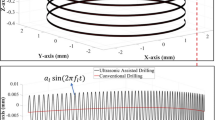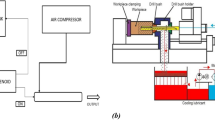Abstract
Inconel 718 is widely applied in aerospace industries as a typical difficult-to-cut material. Especially in its drilling process, the semi-closed cutting environment prevents coolant reaching cutting zones, leading to high cutting temperature and serious tool wear. Internal spray cooling is an effective way to improve cutting performance in drilling process. This paper presented a systematic investigation on the differences in cutting force, tool wear, geometric accuracy, and surface topography of holes in drilling of Inconel 718 assisted by external and internal cooling technologies using nitride-coated tools. The results illustrated that thrust force was much lower when drilling the same number of holes during normal wear and rapid wear stages and the tool life prolonged 2.05 times under internal spray cooling condition than that under conventional external cooling condition. Internal spray cooling produced more stable surface roughness Ra and more accurate hole diameter. Besides, surface defects, including material adhesion, smear, and grooves, were largely improved by internal spray cooling. This paper gave a systematic and detailed understanding of the advantages in drilling Inconel 718 process of internal spray cooling compared with the conventional external cooling.














Similar content being viewed by others
References
Thakur A, Gangopadhyay S (2016) State-of-the-art in surface integrity in machining of nickel-based super alloys. Int J Mach Tools Manuf 100:25–54. https://doi.org/10.1016/j.ijmachtools.2015.10.001
M Saoubi R, Axinte D, Soo SL, Nobel C, Attia H, Kappmeyer G, Serafettin E, Sim WM (2015) High performance cutting of advanced aerospace alloys and composite materials. CIRP Ann-Manuf Technol 64:557–580. https://doi.org/10.1016/j.cirp.2015.05.002
Arunachalam RM, Mannan MA, Spowage AC (2004) Residual stress and surface roughness when facing age hardened Inconel 718 with CBN and ceramic cutting tools. Int J Mach Tools Manuf 44:879–887
Arunachalam RM, Mannan MA, Spowage AC (2004) Surface integrity when machining age hardened Inconel 718 with coated carbide cutting tools. Int J Mach Tools Manuf 44:1481–1491
Zhuang K, Zhu D, Zhang X, Ding H (2014) Notch wear prediction model in turning of Inconel 718 with ceramic tools considering the influence of work hardened layer. Wear 313:63–74
Pawade RS, Joshi S, Brahmankar PK (2008) Effect of machining parameters and cutting-edge geometry on surface integrity of high-speed turned Inconel 718. Int J Mach Tools Manuf 48:15–28
Bhatt A, Attia H, Vargas R, Thomson V (2010) Wear mechanisms of WC coated and uncoated tools in finish turning of Inconel 718. Tribol Int 43:1113–1121
Sharman ARC, Aspinwall DK, Dewes RC, Bowen P (2001) Workpiece surface integrity considerations when finish turning gamma titanium aluminide. Wear 249:473–481
Musfirah AH, Ghani JA, Haron CHC (2017) Tool wear and surface integrity of Inconel 718 in dry and cryogenic coolant at high cutting speed. Wear 376:125–133
Soo SL, Aspinwall DK, Dewes RC (2004) Three-dimensional finite element modelling of high-speed milling of Inconel 718. Proc Inst Mech Eng B-J Eng Manuf 218:1555–1561
Pervaiz S, Rashid A, Deiab I, Nicolescu M (2014) Influence of tool materials on machinability of titanium- and nickel-based alloys: a review. Mater Manuf Process 29:219–252
Ulutan D, Ozel T (2011) Machining induced surface integrity in titanium and nickel alloys: a review. Int J Mach Tools Manuf 51:250–280
Behera BC, Alemayehu H, Ghosh S, Rao PV (2017) A comparative study of recent lubri-coolant strategies for turning of Ni-based superalloy. J Manuf Process 30:541–552
Zhang S, Li JF, Wang YW (2012) Tool life and cutting forces in end milling Inconel 718 under dry and minimum quantity cooling lubrication cutting conditions. J Clean Prod 32:81–87
Hood R, Soo SL, Aspinwall DK, Mantle AL (2018) Tool life and workpiece surface integrity when turning an RR1000 nickel-based superalloy. Int J Adv Manuf Technol 98:2461–2468
Motorcu AR, Kuş A, Durgun I (2014) The evaluation of the effects of control factors on surface roughness in the drilling of Waspaloy superalloy. Measurement 58:394–408
Axinte D, Axinte M, Tannock JDT (2003) A multicriteria model for cutting fluid evaluation. Proc Inst Mech Eng B-J Eng Manuf 217:1341–1353
Devillez A, Schneider F, Dominiak S, Dudzinski D, Larrouquere D (2007) Cutting forces and wear in dry machining of Inconel 718 with coated carbide tools. Wear 262:931–942
Saoubi MR, Axinte D, Herbert C, Hardy M, Salmon P (2014) Surface integrity of nickel-based alloys subjected to severe plastic deformation by abusive drilling. CIRP Ann-Manuf Technol 63.1:61–64
Pusavec F, Deshpande A, Yang S, M Saoubi R, Kopac J, Dillon OW, Jawahir IS (2014) Sustainable machining of high temperature nickel alloy-Inconel 718: part 1-predictive performance models. J Clean Prod 81:255–269
Pusavec F, Deshpande A, Yang S, M Saoubi R, Kopac J, Dillon OW, Jawahir IS (2015) Sustainable machining of high temperature nickel alloy-Inconel 718: part 2-chip breakability and optimization. J Clean Prod 87:941–952
Tazehkandi AH, Shabgard M, Pilehvarian F (2015) On the feasibility of a reduction in cutting fluid consumption via spray of biodegradable vegetable oil with compressed air in machining Inconel 706. J Clean Prod 104:422–435
Mazurkiewicz M, Kubala Z, Chow J (1989) Metal machining with high-pressure water-jet cooling assistance-a new possibility. J Manuf Sci Eng-Trans ASME 111:7–12
Imran M, Mativenga PT, Gholinia A, Withers PJ (2014) Comparison of tool wear mechanisms and surface integrity for dry and wet micro-drilling of nickel-base superalloys. Int J Mach Tools Manuf 76:49–60
Ucak N, Cicek A (2018) The effects of cutting conditions on cutting temperature and hole quality in drilling of Inconel 718 using solid carbide drills. J Manuf Process 31:662–673
Liao YS, Lin HM, Wang JH (2008) Behaviors of end milling Inconel 718 superalloy by cemented carbide tools. J Mater Process Technol 201:460–465
Yan P, Rong Y, Wang G (2016) The effect of cutting fluids applied in metal cutting process. Proc Inst Mech Eng B 230:19–37
Hong SY, Broomer M (2000) Economical and ecological cryogenic machining of AISI 304 austenitic stainless steel. Clean Prod Process 2:157–166. https://doi.org/10.1007/s100980000073
Lawal SA, Choudhury IA, Nukman Y (2013) A critical assessment of lubrication techniques in machining processes: a case for minimum quantity lubrication using vegetable oil-based lubricant. J Clean Prod 41:210–221. https://doi.org/10.1016/j.jclepro.2012.10.016
Lazoglu I, Altintas Y (2002) Prediction of tool and chip temperature in continuous and interrupted machining. Int J Mach Tools Manuf 42:1011–1022
Gu J, Barber G, Tung S, Gu RJ (1999) Tool life and wear mechanism of uncoated and coated milling inserts. Wear 225:273–284
Wijeyewickrema AC, Keer LM, Ehmann KF (1995) Drill wandering motion: experiment and analysis. Int J Mech Sci 37:495–509
Bono M, Ni J (2001) The effects of thermal distortions on the diameter and cylindricity of dry drilled holes. Int J Mach Tools Manuf 41:2261–2270
Laguna-Camacho JR, Lewis R, Vite-Torres M, Mendez-Mendez JV (2013) A study of cavitation erosion on engineering materials. Wear 301:467–476. https://doi.org/10.1016/j.wear.2012.11.026
Cheng F, Ji W, Qian C, Xu J (2018) Cavitation bubbles dynamics and cavitation erosion in water jet. Results Phys 9:1585–1593. https://doi.org/10.1016/j.rinp.2018.05.002
Sreedhar BK, Albert SK, Pandit AB (2017) Cavitation damage: theory and measurements-a review. Wear 372:177–196. https://doi.org/10.1016/j.wear.2016.12.009
Hu HX, Zheng YG, Qin CP (2010) Comparison of Inconel 625 and Inconel 600 in resistance to cavitation erosion and jet impingement erosion. Nucl Eng Des 240:2721–2730. https://doi.org/10.1016/j.nucengdes.2010.07.021
Li Z, Zhou J, Han J, Chen J (2016) Formation of cavitation-induced nanosize precipitates on the eroded surface for Inconel 718 alloy. Mater Lett 164:267–269. https://doi.org/10.1016/j.matlet.2015.10.122
Hattori S, Ishikura R (2010) Revision of cavitation erosion database and analysis of stainless steel data. Wear 268:109–116. https://doi.org/10.1016/j.wear.2009.07.005
Li Z, Han J, Lu J, Zhou J, Chen J (2014) Vibratory cavitation erosion behavior of AISI 304 stainless steel in water at elevated temperatures. Wear 321:33–37. https://doi.org/10.1016/j.wear.2014.09.012
Acknowledgments
The authors would like to acknowledge the financial support from “National Nature Science Foundation of China (51605326),” the “Natural Science Foundation of Tianjin (17JCQNJC04000 and 16JCZDJC38300),” and “Research on the high efficiency machining technologies of GH4169 (X-process-20161037-071).”
Author information
Authors and Affiliations
Corresponding author
Additional information
Publisher’s note
Springer Nature remains neutral with regard to jurisdictional claims in published maps and institutional affiliations.
Rights and permissions
About this article
Cite this article
Qin, X., Liu, W., Li, S. et al. A comparative study between internal spray cooling and conventional external cooling in drilling of Inconel 718. Int J Adv Manuf Technol 104, 4581–4592 (2019). https://doi.org/10.1007/s00170-019-04330-9
Received:
Accepted:
Published:
Issue Date:
DOI: https://doi.org/10.1007/s00170-019-04330-9




